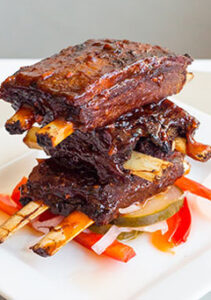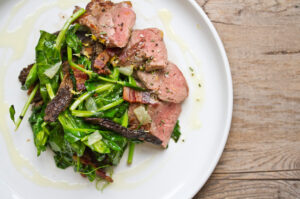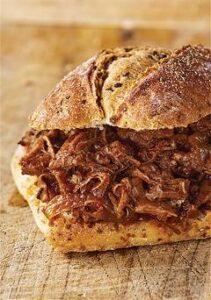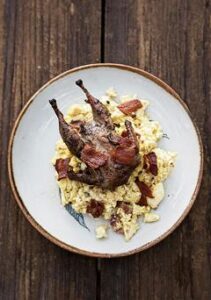


Go Wild
Cooking with wild game doesn’t have to be a risky culinary adventure—learn how to make the most of your hunted meat with these tips.
By Abigail Boatwright
Hunting season is here, and that often means freezers full of fresh game. Cooking with game can be tricky, and we’ve probably all had an unfortunate encounter with “gamey” tasting meat. To help you avoid this experience and get the most out of your wild protein, celebrity chef Tim Love, founder of famous Fort Worth eateries including Lonesome Dove Western Bistro, the Love Shack and the Woodshed, offers his expertise.
All too often, meats such as venison or boar have a distinctive, sometimes unpleasant, taste that can turn people off of wild game dishes in a hurry. Tim says this is most often due to improper processing after the hunt, not the meat itself.
“Especially with venison, the animal sometimes gets field dressed [removing the internal organs] and then it is brought back to the house,” Tim said. “If it isn’t hung up for a couple of days, the blood from the animal stays within the muscle as opposed to leaking out, which is what you want. That blood is what provides the gamey, metallic, livery flavor. The better it is cleaned, the more pure, natural flavor that meat is going to have.”
Commercially processed wild game often lacks the gamey flavor because it has been well-prepared, Tim says.
Another mistake that can lead to poor game meat flavor is straight substitution of wild game for domestic meats. Wild game is almost always leaner, Tim says, requiring different cooking techniques to retain a moist, tender texture.
“If you take a whole rabbit, the tenderloins are great to grill, but the legs need to be slow cooked,” Tim said. “Unlike when you roast a chicken, where you roast it all pretty easily, the legs of a rabbit are better to be served braised over a long period of time or cooked in fat for four to six hours until they are just falling apart, so they don’t dry out.”
Tim recommends cooking game two ways: slowly, or wrapping it with a form of fat, known as larding, before cooking.
“Wrapping the outside of a rabbit leg with bacon, for example, and then slow grilling it with direct heat would work nicely,” Tim said. “Basically, you are adding a layer of skin to the meat.”
If you have big game such as deer or boar, Tim says the primal cuts—which include the round, loin, rib, chuck, ham, butt or picnic— are best grilled or cooked with simple methods. Other cuts of meat lend themselves well to stews and slow cooking.
For red meats such as venison or elk, Tim stresses not to overcook the meat to achieve the perfect texture.
“If you overcook those meats, they are going to become very, very tough, and they are going to be mealy,” Tim said. “That meat has such a velvety texture, but once it is cooked, meaning the internal temperature is above 140°, it really turns tough. The texture of the protein itself just turns stringy, and it provides a really bad mouth feel. You want to make sure that you get a really hard sear on the outside to get some texture and crunch, and leave the center rare. That is how you keep the velvety texture to the meat.”
Lumping all wild meats into one “game” category is a mistake, Tim says. Quail tastes completely different from elk, for example, and the two meats must be prepared in different ways.
“What I love most about cooking with wild game is that each meat has a distinct flavor all its own,” Tim said.
Tim’s personal favorite category is red meats, especially antelope and elk.
“I just love the texture of the meat, especially the loins and the primal cuts. They’re just super delicious,” he said. “They really absorb flavor from rubs really quickly because there’s not very much fat.”
Tim says consuming game meats is not as crazy as some might think. Proteins such as rabbit are actually environmentally friendly, as well as healthy.
“Unbeknownst to most people, the most [Earth] friendly meat to eat in the world is rabbit,” Tim said. “They have zero carbs, they eat lettuce and they multiply quickly. It has the least effect on our planet. It’s very good for you; it’s lean just like chicken, and there is hardly any fat.”
If you’re not sure about trying wild game, you don’t have to leap in “whole hog.” One of Tim’s favorite ways to substitute is by using wild turkey instead of farm-raised turkey.
“We always shoot a wild turkey for Thanksgiving,” Tim said. “It is super lean, so it needs to be roasted very slowly on a low temperature. Or you can do a new recipe of mine: I wrap the whole turkey in pancetta, and roast it. It comes out really pretty, like it’s got these beautiful shingles of pancetta.”
Another way he likes to prepare game is simple grilled dove.
“Everybody takes the dove, wraps in bacon, adds some jalapeno and cream cheese and it and then they grill them,” Tim said. “But the most pure, beautiful thing I can do is just prepare well seasoned and grilled dove breasts. With the skin on, it takes a lot of time to clean it that way instead of just pulling off the breasts. But if you take the time to pluck it, and leave that skin on there, it makes all the difference in the world. It makes a really beautiful piece of meat when you grill it.”
 Wild Boar Ribs
Wild Boar Ribs1 stalk celery, chopped
4 carrots, chopped
4 red onions, julienned
20 cloves of garlic
1 tsp thyme
1 tsp peppercorns
6 bay leaves
1 tsp Lonesome Dove Game Rub
1 tsp cinnamon
30-lb. center cut wild boar ribs
Lonesome Dove BBQ Sauce
Recipe courtesy of Lonesome Dove Western Bistro
Photo credit Aimee Wenske

Wild boar meat has a lot of flavor … sometimes it’s best to cook it simply and let its natural character carry the dish. This recipe could easily be adapted for the grill.
2 wild boar tenderloins
1 tsp minced fresh rosemary leaves
Salt and pepper
Serve with the sides of your choice—a Bacon, Morels & Pea Vines Sauté is perfect.. Pair with pinot noir.
Recipe courtesy Marx Foods
Photo credit: Ryan Clark, Marx Foods

This is a great slow cooker recipe. You can use elk or venison for this and the long, slow cook will create one of the best pulled meat sandwich around. Try serving it on an onion bun.1 ½ cups ketchup
3 tablespoons brown sugar
1 tablespoon dry mustard powder
1 tablespoon lemon juice
1 tablespoon liquid smoke flavoring
1 teaspoon onion powder
1 teaspoon garlic powder
2 teaspoons celery salt
2 teaspoons ground black pepper
2 teaspoons Worcestershire sauce
1/8 teaspoon ground nutmeg
3 drops hot pepper sauce
1 (4 pound) elk roast, cut in half
10 hamburger buns, split
Recipe and photo courtesy Legendary Whitetails

8 oz. good-quality bacon, diced
4 semi-boneless quail
Salt and pepper
8 eggs, beaten
4 oz. sharp cheddar cheese, grated
Recipe courtesy Texas Quail Farms
Photo credit: Jody Horton
SHARE THIS